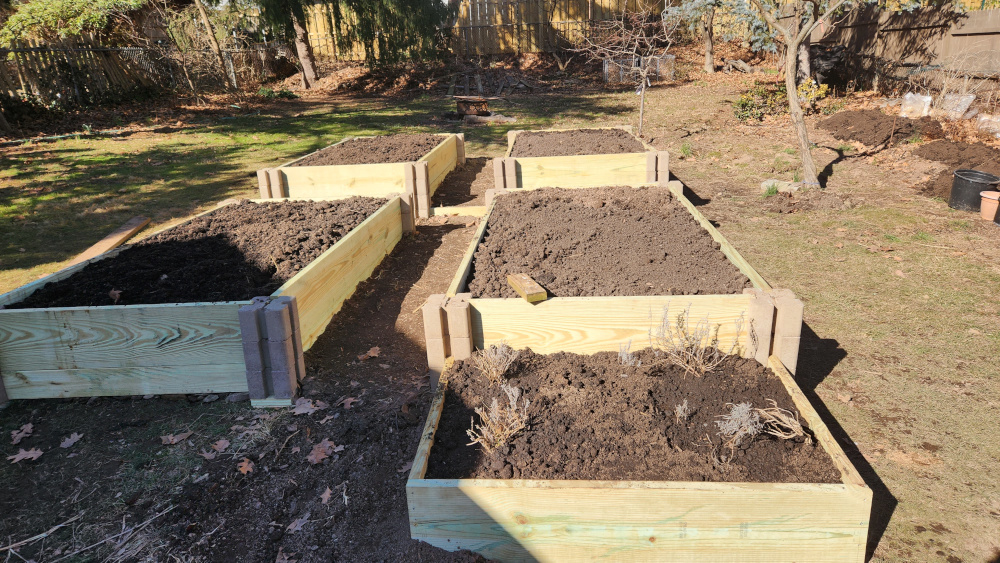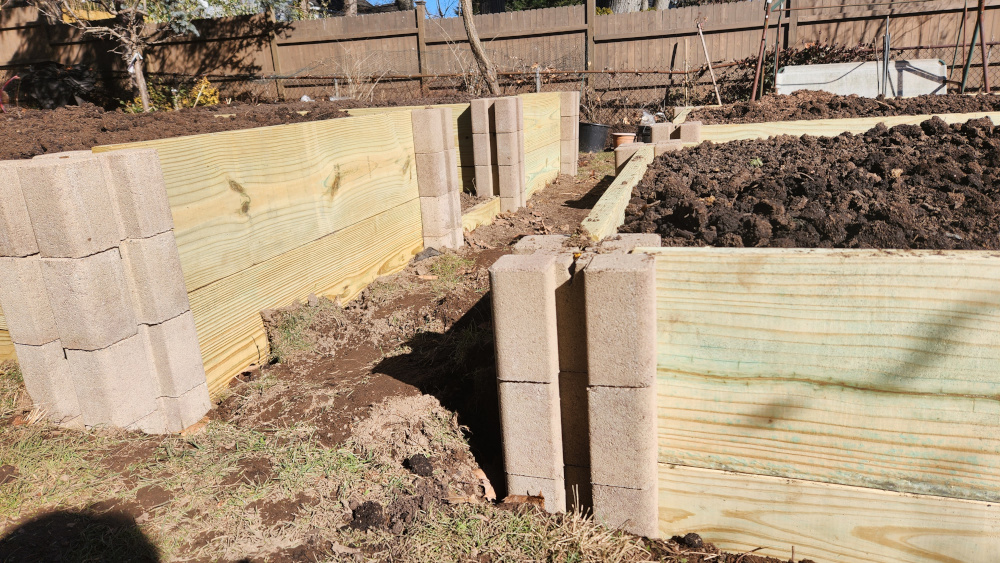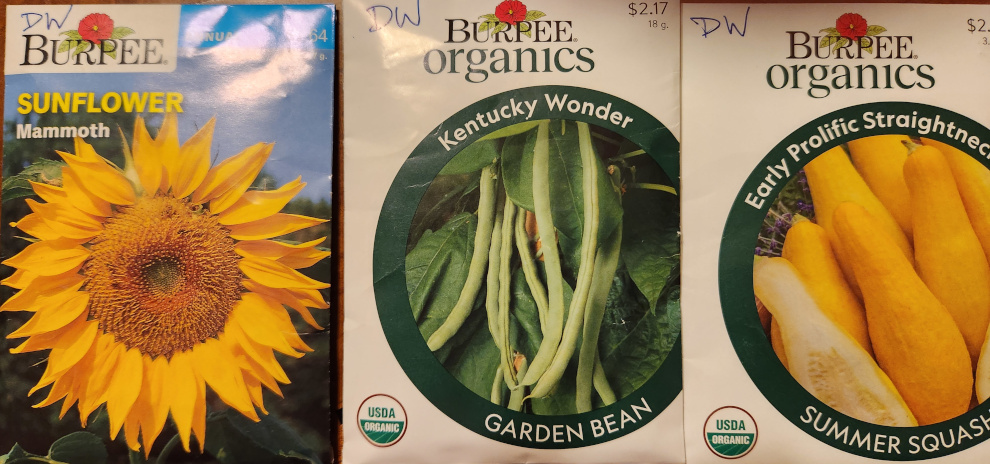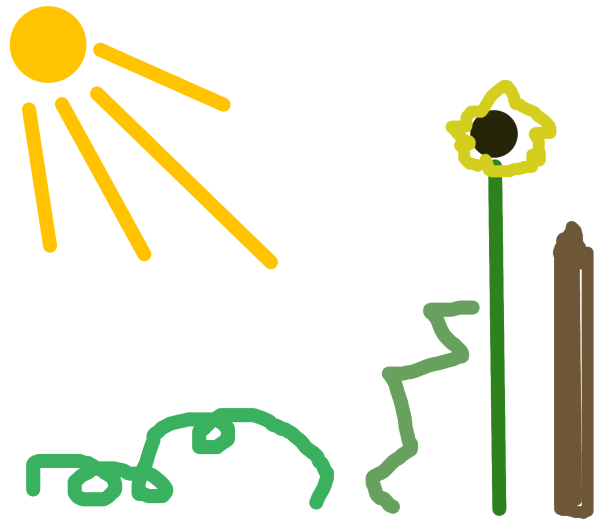Gardening Log 1 (with planting schedule infographic)
As our family investigates permaculture and sustainability and the joy of being poor farmers, we set up some raised garden beds in our 1/4 acre lot. This year is really warm. Thursday’s weather forecast is 64℉ (18℃). In the middle of winter! When it’s supposed to be the coldest time of year!

Some lavenders found their way in a front bed built just for them.

Remnants of construction: Broken up sod and a bare path yet to be covered with woodchips.
We still need to build hoop frames and put netting over the garden beds.
Sowing Preferences #
According to various YouTube videos, some plants do better when sowed directly outside, and others are better started indoors because of our short growing season.
Direct Sow
The seeds are really tiny, or the plant species dislikes transplant shock.
- Peas
- Beans
- Some melons
- Carrots
- Beets
- Alfafa
Indoor Start
- Tomatoes
- Zucchinis
- Cucumbers
- Peppers
- Eggplants
Planting Schedule Infographic #
Download formats:
ODS (Excel, LibreOffice Calc) | PDF Version | SVG (InkScape, Illustrator)
I stole the design from Vegetable Planting Calendar.
Improvements over theirs (because I’m a technical writer so I have to one-up them):
Ordered crops based on time, so the earliest starters come first.
Indicated which seeds are simply better to direct sow outside. The * marks which ones are typically direct sowed.
- For example, Okra can be started inside as a decorative variety, so it has a green section. Okra is a warm-climate plant.
- Some seeds are just so fussy that you might as well start outside, like peas and carrots.
- Herbs like basil, thyme, oregano: they can be grown indoors in a pot… almost indefinitely if taken care of. Use your discretion.
Flowers!
It’s not the prettiest looking thing. I initially made the infographic in LibreOffice because I had a lot of numbers to cross-reference between with our seed packet intructions and general internet wisdom.
I dragged rectangles around until the bars lined up. Each bar consists of up to 3 rectangles: a green bar, a gradient between green and yellow for transition seedlings, and a bar for yellow to harvest. In LibreOffice, you can copy-paste rectangles into a cell and they line up the the upper left corner of that cell.
Then I saved it as an intermediary PDF, opened the PDF in Inkscape, arranged the text so it looks ok, and saved it as a final final PDF.
Save yourself the trouble and download a template that’s ready to go.
Last Frost Date #
The Last Frost Date is super subjective, because it depends on how much volume you’re planning to push out (as a business versus as a hobby), where you live, and your risk tolerance.
After consulting several last-frost-date calculators, I determined May 5th as the Last Frost Date of our climate (USDA Zone 6b), because it’s close to Mother’s Day, and I like the number 5.
Then I used Seed-Starting Date Calculator for some of the seeds we had, because it’s comprehensive. It needs your Last Frost Date.
Experiments #
I’m not a green thumb, and I’m not familiar with agricultural practices at all, so the most I can do is read a lot and prepare to the best of my ability. I want to try a few things: companion planting, germinating old seeds, and pest control.
Three Sisters Method #
The Three Sisters growing method is a touted form of companion planting from North America. The staple crops of corn, bean, and squash are grown together. It saves space for subsistence farmers.
Corn is the eldest sister who provides stability. Bean is the middle sister who provides nutrition (mostly nutrition for humans, but it’s also a nitrogen-fixing plant). Squash is the protective sister who shades the ground, keeping it moist and free of weeds.
There are dissenters who argue this method sucks, because modern crop varieties are ill-suited to ancient methods, and the Three Sister’s method is no more than just wives’ tales.
This spring I will experiment with a version that hopefully works in our day and age. There are actually a few different interpretations of the Three Sister’s Method.
Sunflower #

I’m going to try this method. Instead of corn, use sunflower.
Corn needs to grow in blocks to wind pollinate, otherwise you’ll harvest no corn. They also need a lot of fertilizer and water. With the decline of bees, I’m not so confident that growing corn is worth it.
Sunflowers can attract birds and other pests away from our vegetables, so they would be great to grow along a fence.
Instructions:
- Create mounds about 18" in diameter.
- Sow a sunflower seed in the center of each mound.
- Insert halved water bottles as protection from animals who like to eat seedlings.
- When the sunflowers are big enough, like 3", take out the water bottles.
- When sunflowers are 6" high, plant 1 pole bean for each sunflower, or 2 pole beans on each side of a sunflower, or 3 in a triangle formation. When they grow up they can ground the sunflower like a tent pitch.
- At the same time, plant a squash around the edge of the mound, or between mounds.
- Modern squash plants grow huge, especially vine varieties.
- Don’t grow them where you need to walk.
- Check daily, take out weeds, and train the beans and squash to grow neatly.
Overall ratio of sunflower:bean:squash is close to 2:2:1.
Some people argue that sunflowers are allelopathic, which means they’re poisonous to beans, but I think it’s a bit overblown.
Raising up mounds, mulching and fertilizer, and planting the seeds in a sensible location are more important. Taking into account where the sun shines on our yard, I will plant the shorter plants closer to the sunspot. If we have to prune the sunflowers so their leaves don’t block everything, then so be it.
Something like:

Autumn Harvest (Low Maintenance Version) #
This is the low-maintenance version where you don’t have to visit your crops very often and inadvertently compact the soil around your Three Sisters mound.
Grow a hard and tall/strong corn variety, like dent corn. Grow fall-harvest varieties that are left on the stalk until they dry.
Dry corn, dry beans, dry gourds and winter squash (like pumpkin).
Plot-wise Rotation #
Grow one variety per plot, but rotate every year.
- Year 1: Grow corn, harvest the corn, and leave the dry stalks in the ground.
- Year 2: Grow beans up the dead stalks.
- Year 3: Smash everything down the next spring and plant squash.
Then back to corn.
Will 12-year-old seeds sprout? #
We have dill and sage seeds that are 12 years old. Their best-by dates are from 2009. Let’s see if any of them survived.
Pinwheels #
In order to deter birds, we will need a few pinwheels around our plots. Also, the pinwheels need to be moved every week. The reflective ones flash like turbines of death, so I wouldn’t be surprised if a bird just goes, “Nope!”
Watering schedule #
Water every 2-3 days once your plants have adult leaves. If you water too frequently, the crops won’t grow deep roots because of learned helplessness. As long as there’s enough water on the surface, they’ll just stay there comfortably. For root crops like carrots, you really want them to reach down.
Anyway, that about sums up my thoughts for this season. We’ll see how to harvest sunflowers before the birds eat all of them, or how many fungicides and pesticides we’ll need.
Next: Gardening Log 2
